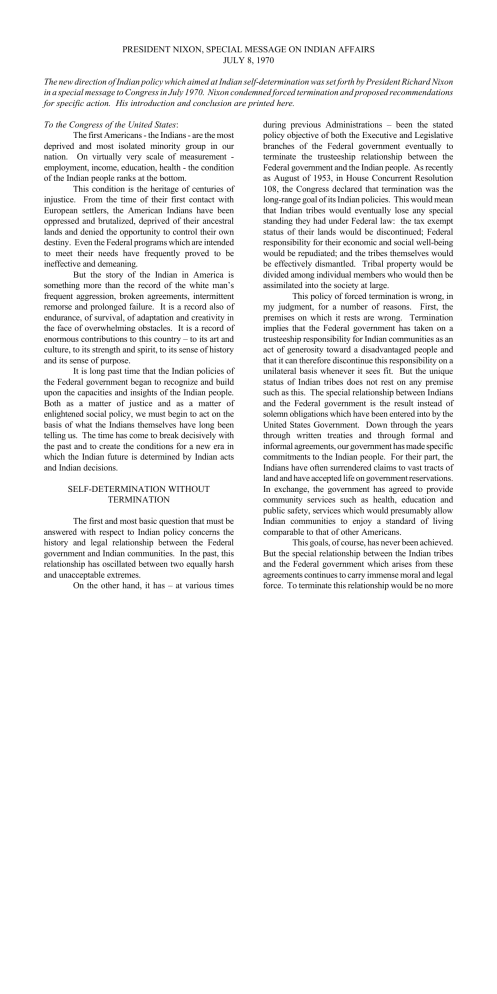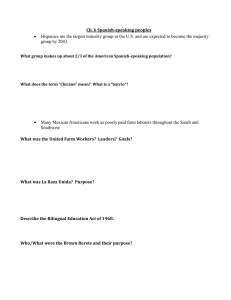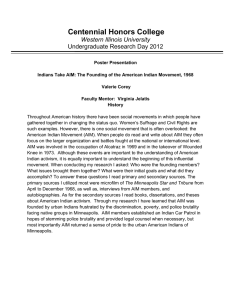PRESIDENT NIXON, SPECIAL MESSAGE ON INDIAN AFFAIRS JULY 8, 1970

PRESIDENT NIXON, SPECIAL MESSAGE ON INDIAN AFFAIRS
JULY 8, 1970
The new direction of Indian policy which aimed at Indian self-determination was set forth by President Richard Nixon in a special message to Congress in July 1970. Nixon condemned forced termination and proposed recommendations for specific action. His introduction and conclusion are printed here.
To the Congress of the United States :
The first Americans - the Indians - are the most deprived and most isolated minority group in our nation. On virtually very scale of measurement employment, income, education, health - the condition of the Indian people ranks at the bottom.
This condition is the heritage of centuries of injustice. From the time of their first contact with
European settlers, the American Indians have been oppressed and brutalized, deprived of their ancestral lands and denied the opportunity to control their own destiny. Even the Federal programs which are intended to meet their needs have frequently proved to be ineffective and demeaning.
But the story of the Indian in America is something more than the record of the white man’s frequent aggression, broken agreements, intermittent remorse and prolonged failure. It is a record also of endurance, of survival, of adaptation and creativity in the face of overwhelming obstacles. It is a record of enormous contributions to this country – to its art and culture, to its strength and spirit, to its sense of history and its sense of purpose.
It is long past time that the Indian policies of the Federal government began to recognize and build upon the capacities and insights of the Indian people.
Both as a matter of justice and as a matter of enlightened social policy, we must begin to act on the basis of what the Indians themselves have long been telling us. The time has come to break decisively with the past and to create the conditions for a new era in which the Indian future is determined by Indian acts and Indian decisions.
SELF-DETERMINATION WITHOUT
TERMINATION
The first and most basic question that must be answered with respect to Indian policy concerns the history and legal relationship between the Federal government and Indian communities. In the past, this relationship has oscillated between two equally harsh and unacceptable extremes.
On the other hand, it has – at various times during previous Administrations – been the stated policy objective of both the Executive and Legislative branches of the Federal government eventually to terminate the trusteeship relationship between the
Federal government and the Indian people. As recently as August of 1953, in House Concurrent Resolution
108, the Congress declared that termination was the long-range goal of its Indian policies. This would mean that Indian tribes would eventually lose any special standing they had under Federal law: the tax exempt status of their lands would be discontinued; Federal responsibility for their economic and social well-being would be repudiated; and the tribes themselves would be effectively dismantled. Tribal property would be divided among individual members who would then be assimilated into the society at large.
This policy of forced termination is wrong, in my judgment, for a number of reasons. First, the premises on which it rests are wrong. Termination implies that the Federal government has taken on a trusteeship responsibility for Indian communities as an act of generosity toward a disadvantaged people and that it can therefore discontinue this responsibility on a unilateral basis whenever it sees fit. But the unique status of Indian tribes does not rest on any premise such as this. The special relationship between Indians and the Federal government is the result instead of solemn obligations which have been entered into by the
United States Government. Down through the years through written treaties and through formal and informal agreements, our government has made specific commitments to the Indian people. For their part, the
Indians have often surrendered claims to vast tracts of land and have accepted life on government reservations.
In exchange, the government has agreed to provide community services such as health, education and public safety, services which would presumably allow
Indian communities to enjoy a standard of living comparable to that of other Americans.
This goals, of course, has never been achieved.
But the special relationship between the Indian tribes and the Federal government which arises from these agreements continues to carry immense moral and legal force. To terminate this relationship would be no more
appropriate than to terminate the citizenship rights of any other American.
The second reason for rejecting forced termination is that the practical results have been clearly harmful in the few instances in which termination actually has been tried. The removal of
Federal trusteeship responsibility has produced considerable disorientation among the affected Indians and has left them unable to relate to a myriad of
Federal, State an local assistance efforts. Their economic and social condition has often been worse after termination than it was before.
The third argument I would make against forced termination concerns the effect it has had upon the overwhelming majority of tribes which still enjoy a special relationship with the Federal government. The very threat that this relationship may someday be ended has created a great deal of apprehension among Indian groups and this apprehension, in turn, has had a blighting effect on tribal progress. Any step that might result in greater social, economic or political autonomy is regarded with suspicion by many Indians who fear that it will only bring them closer to the day when the
Federal government will disavow its responsibility and cut them adrift.
In short, the fear of one extreme policy, forced termination, has often worked to produce the opposite extreme: excessive dependence on the Federal government. In many cases this dependence is so great that the Indian community is almost entirely run by outsiders who are responsible and responsive to Federal officials in Washington, D.C., rather than to the communities they are supposed to be serving. This is the second of the two harsh approaches which have long plagued our Indian policies. Of the Department of
Interior/s programs directly serving Indians, for example, only 1.5 percent are presently under Indian control. Only 2.4 percent of HEW’s Indian health programs are run by Indians. The result is a burgeoning Federal bureaucracy, programs which are far less effective than they ought to be, and an erosion of Indian initiative and morale.
I believe that both of these policy extremes are wrong. Federal termination errs in one direction,
Federal paternalism errs in the other. Only by clearly rejecting both of these extremes can we achieve a policy which truly serves the best interests of the Indian people. Self-determination among the Indian people can and must be encouraged without the threat of eventual termination. In my view, in fact, that is the only way that self-determination can effectively be fostered.
This, then, must be the goal of any new national policy toward the Indian people to strengthen the Indian’s sense of autonomy without threatening this sense of community. We must assure the Indian that he can assume control of his own life without being separated involuntary from the tribal group. And we must make it clear that Indians can become independent of Federal control without being cut off from Federal concern and Federal support. My specific recommendations to the Congress are designed to carry out this policy....
The recommendations of this administration represent an historic step forward in Indian policy. We are proposing to break sharply with past approaches to
Indian problems. In place of a long series of piecemeal reforms, we suggest a new and coherent strategy.
In place of policies which simply call for more spending, we suggest policies which call for wiser spending. In place of policies which oscillate between the deadly extremes of forced termination and constant paternalism, we suggest a policy in which the Federal government and the Indian community play complementary roles.
But most importantly, we have turned from the question of whether the Federal government has a responsibility to Indians to the question of how that responsibility can best be furthered. We have concluded that the Indians will get better programs and that public monies will be more effectively expended if the people who are most affected by these programs are responsible for operating them.
The Indians of America need Federal assistance – this much has long been clear. What has not always been clear, however, is that the Federal government needs Indian energies and Indian leadership if its assistance is to be effective in improving the conditions of Indian life. It is a new and balanced relationship between the Unites States government and the first Americans that is at the heart of our approach to Indian problems. And that is why we now approach these problems with new confidence that they will successfully be overcome.
[ Public Papers of the Presidents of the United States:
Richard Nixon, 1970, pp. 564-567, 576-76.
]





